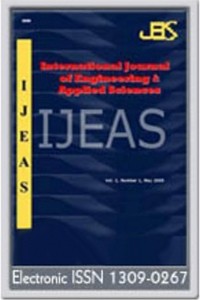Active Suspension of Cars Using Fuzzy Logic Controller Optimized by Genetic Algorithm
In the literature, there are many studies based on adaptive control methods to improve the properties of the vehicle suspension systems. In this work, fuzzy logic is used to control the active suspension and the membership functions are optimized by using genetic algorithm operations. By using the fuzzy logic and proportional, integral, derivative (PID) controller methods, the vehicle body deflections and the control force have been obtained and compared with each others. These comparisons displayed the efficiency and convenience of the offered fuzzy logic controller (FLC) method. The study shown that the proposed method can be used for the active control of car suspension systems
Keywords:
Active suspension systems fuzzy logic control, genetic algorithm, PID control, quarter-car reference model,
___
- [1] Yagiz, N., Hacioglu, Y., Backstepping control of a vehicle with active suspensions, Control Engineering Practice, 2-11, 2008.
- [2] Karnopp, D., Analytical results for optimum actively damped suspension under random excitation, Journal of Acoustic Stress and Reliability in Design, 111, 278-283, 1989.
- [3] Sun, L., Optimum design of ‘road-friendly’ vehicle suspension systems subjected to rough pavement surfaces, Applied Mathematical Modeling, 26, 635-652, 2002.
- [4] Sireteanu, T., Stoia, N., Damping optimization of passive and semi-active vehicle suspension by numerical simulation, Proceedings of the Romanian Academy, 2003.
- [5] Sun, L., Cai, X., Yang, J., Genetic algorithm-based optimum vehicle suspension design using minimum dynamic pavement load as a design criterion, Journal of Sound and Vibration 301, 18-27, 2007.
- [6] Sun, L., On human perception and evaluation to road surfaces, Journal of Sound and Vibration, 247, 547-560, 2001.
- [7] Sunwoo, M., Cheok, K.C., Huang, N.J., Model reference adaptive control for vehicle active suspension systems, Institute of Electrical and Electronics Engineers Transactions on Industrial Electronics, 38, 217-222, 1991.
- [8] Baumal, A.E., McPhee, J.J., Calamai, P.H., Application of genetic algorithms to the design optimization of an active vehicle suspension system, Computational Methods in Applied Mechanics Engineering, 163, 87–94, 1998.
- [9] Meditch, J.S., Stochastic optimal linear estimation and control, McGraw-Hill, New York, 1969.
- [10] Yoshimura, T., Nakaminami, K., Kurimoto, M., Hino, J., Active suspension of passenger cars using linear and fuzzy-logic controls, Control Engineering Practice 7, 41–47, 1999.
- [11] Lin, Y-J., Lu, Y-Q., Padovan, J., Fuzzy logic control of vehicle suspension systems, International Journal of Vehicle Design, 14, 457- 470, 1993.
- [12] Roukich, S., Titli, A., Design of active and semi-active automotive suspension using fuzzy logic, IFAC 12 th World Congress 2 Sydney, 253–257, 1993.
- [13] Yeh, E.C., Tsai, Y.J., A fuzzy preview control scheme of active suspension, International Journal of Vehicle Design 15(1/2), 166–180, 1994.
- [14] Yoshimura, T., Itoh, Y., Hino, J., Active suspension of motor coaches using skyhook damper and fuzzy logic controls, Control Engineering Practice 5(2), 175–184, 1997.
- [15] Bingül, Z., Matlab ve Simulik’le Modelleme/Kontrol I-II, birinci bas., Birsen Yayınevi, İstanbul, 2005
- Başlangıç: 2009
- Yayıncı: Akdeniz Üniversitesi
Sayıdaki Diğer Makaleler
R. K. PEKGÖKGÖZ, M. A. GÜREL, M. BİLGEHAN, M. KISA
M. SEDİGHİZADEH, M. M. HOSSEİNİ
Md. Mahfuz SARWAR, Mohammad MASHUD
E. AKCALİ, H. ARMAN, S. FİRAT, L. SALTABAS, Z. GUNDUZ
